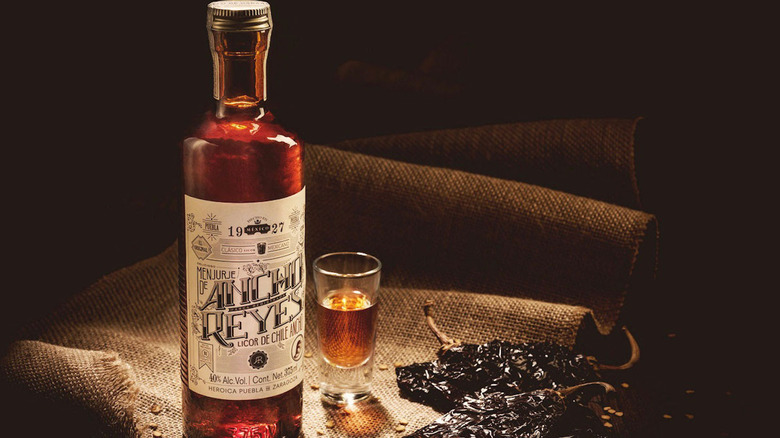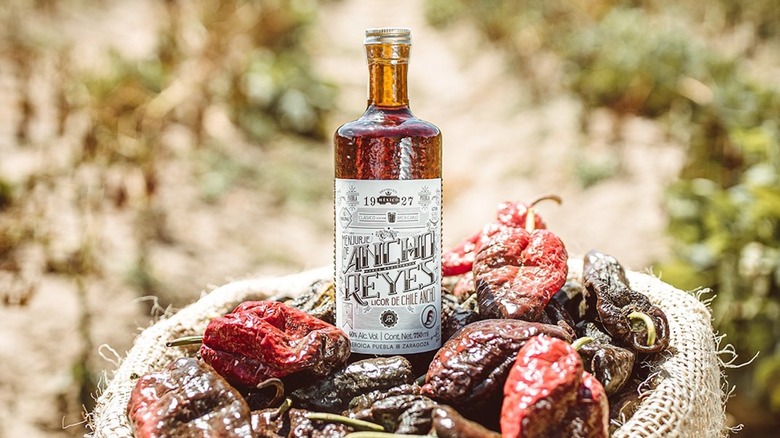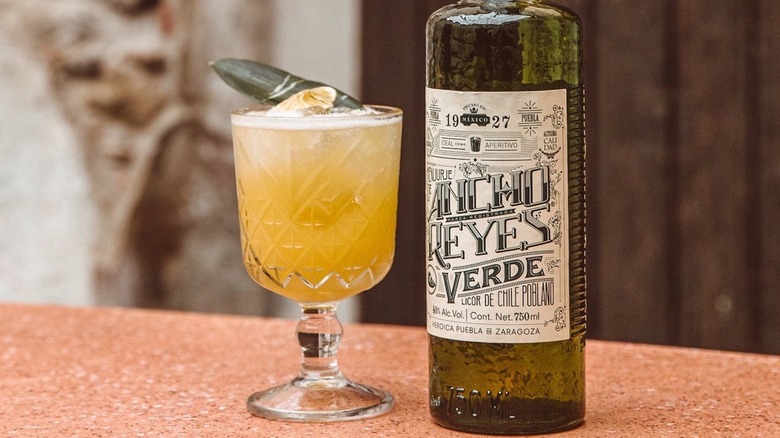How To Use Ancho Reyes Liqueur For A Spicy Cocktail Twist
If you're looking to add some spice to your life, you might try snagging a bottle of Ancho Reyes liqueur for your cocktail cart. The fiery spirit is infused with ancho chiles and boasts a complex flavor profile that adds depth and heat to drinks. The brand — which Campari Group described as "offering an ideal fit to mixology as a foundation for innovative cocktails" in a press release upon acquiring controlling interest in 2019 — was launched stateside in 2012 after Iván Saldaña Oyarzábal, a distiller and authority on agave spirits, stumbled upon the Reyes family recipe that dates back to the 1920s.
The chile liqueur is made using two main ingredients: sun-dried ancho chiles and 55% ABV cane spirit from Veracruz, Mexico. The chiles steep in the alcohol for six months to yield a bold mosaic of smoky, sweet, and spicy flavors that can be incorporated into various recipes.
But how can you use this elixir to spice up your cocktail game? Different ways to substitute sweeteners with the liqueur include adding it to classic margaritas for added smokiness or a slow-burning Old Fashioned. However, it can also give an extra kick to already-spicy cocktails, like adding Ancho Reyes to a spicy bloody mary to awaken your taste buds in the morning. If your next happy hour could use a little heat, it's easy to incorporate Ancho Reyes liqueur into any mixed drink for a unique cocktail twist.
What makes Ancho Reyes liqueur a smoldering celebration?
The flavor profile of Ancho Reyes is based on a recipe from 1927 and relies on the slow maceration of chiles and other spices. During this process, the peppers blend with the cane spirit, yielding robust flavors of caramelized peppers, cinnamon, tamarind candies, and cacao. At the end of an Ancho Reyes sip, you'll feel that feisty bite of chiles.
What's fascinating about Ancho Reyes, though, is that the heat of the chiles isn't overwhelming, which can be the case when using naturally spicy ingredients like jalapeño peppers in cocktails. Instead, it adds a tingle to the palate without causing you to break out into a sweat. Bartender Simone Goldberg told Punch, "If you're using jalapeño, upfront, you get that immediate spiciness," whereas Ancho Reyes is more subdued, lending "more of a subtle finish to a drink."
The brand also offers a Verde option that uses fire-roasted poblano chiles for a resulting spirit with more freshness and vegetal qualities than the ancho chile-based version. Due to their chile and cane spirit base, either one of Ancho Reyes' liqueurs works well as a sweet substitute in cocktails begging for more dimension. Likewise, they work well when used to complement other fiery ingredients like chile-infused vodka.
Using Ancho Reyes liqueur in cocktails
Want to add some fire to a sweeter cocktail? Swap out the sugar component for some Ancho Reyes. Interested in sticking to (and spicing up) the classics? By pouring in just a splash of the liqueur, you can give any margarita a spicy edge. The drink's juicy lime flavors help offset the heat of the chile liqueur while yielding a layered and peppery libation. Meanwhile, Shannon Ponche's riff on a Negroni Sbagliato, The Edsel, calls for Ancho Reyes' piquantness to balance out the sweetness of sherry and sweet vermouth.
You can also swap out hot sauce for Ancho Reyes to turn up the heat in a Michelada or use it as a Tabasco substitute in a bloody mary recipe so that the Mexican chile liqueur tempers the drink's acidity with its sweetly cinnamon-spiced smooth kick of heat. Another option is the Ancho Old Fashioned. Replace the sugar cube with ½ ounce of simple syrup and an ounce of red Ancho Reyes. Mix it in a glass with an ounce of smoky bourbon and a couple of dashes of both orange and Angostura bitters before giving it a stir and garnishing it with orange zest. Regardless of how you use either expression of Ancho Reyes, its lowkey spice and sweetness makes it a more versatile liqueur than it might initially seem.


